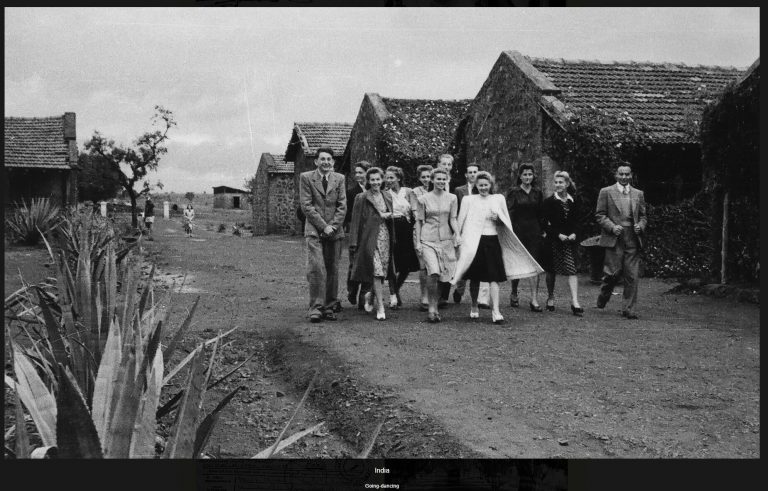
Under the direction of the British, Polish refugees from the Soviet Union travelled from Persia to transit camps in Sindh, and finally to the Valivade camp in 1943.
Uttara Shahani
On 14 September 2019, Poland’s Deputy Foreign Minister Marcin Przydacz unveiled a memorial pillar in the village of Valivade near the city of Kolhapur in India. Polish refugees had lived in a camp at Valivade between 1943 and 1948, just before and for a short time after the partition of India and the British departure from India in 1947. Under the direction of the British, Polish refugees from the Soviet Union travelled from Persia to transit camps in Sindh, and finally to the Valivade camp in 1943. A few years later, from March 1948, Sindhi Hindu refugees of partition arrived at the very same camp, having been ‘dispersed’ there by the Indian government.
The multi-layered history of the people who lived in Valivade reveals a connected feature of British imperial and postcolonial policy: ‘dispersal’. Following the precedent of holding their prisoners of war at locations across their vast empire, as they had during the Boer War and World War One, the British transported World War Two internees and evacuees all over the empire, including to India. This policy was underpinned by the desire to block refugees and internees from entering the UK. India became a central prong of the strategy, as the British government decided to disperse and ‘hold’ diverse groups of refugees and prisoners of war in British India and in the Indian princely states—semi-autonomous regions subject to a form of indirect rule under their own sovereigns. The princely states became important sites of dispersal when the British leaned on them to accept World War Two evacuees. Very soon afterwards the new Indian government did the same, for partition refugees.
By the time World War Two started, Europeans were already seeking refuge in India. From May 1938, German passport holders needed a visa to enter the UK and its colonies, as the UK wanted to restrict the number of Jews seeking refuge on its territory, especially those who might be ‘destitute’ and considered a burden on the UK. Nonetheless, from the 1930s, Jewish refugees, particularly Austrians and Germans, applied for visas to enter British India. The colonial government of India permitted a restricted number of Jewish refugees into the territory while interning several of them as ‘enemy aliens’ in camps dotted about the country.

During the war, while approximately half a million Indians were displaced across South and South East Asia, more Europeans were entering India. After Stalin freed his Polish prisoners when Germany attacked the Soviet Union in 1941, they formed a Polish army under the leadership of General Wladyslaw Anders. The British were involved in evacuating ‘Anders’ Army’ from the Soviet Union via British-controlled Persia so that its fighters could join the Allied forces. Anders allowed thousands of Polish civilians and orphans in various stages of illness to join his convoys. After the Polish government-in-exile came to an agreement with the UK over financing the refugees’ maintenance, the British dispatched the civilian Poles to their African colonies as well as 5,000 of them to India, mainly to the princely territories of Valivade and Balachadi in Nawanagar.
At the end of the war, the question arose: where to permanently resettle the former European prisoners of war and refugees in India, many of whom could not return to their countries of origin. While the plans to settle some Jewish refugees in various parts of the British empire are documented, these plans were in fact part of a larger UK effort to disperse displaced persons (as internees also came to be known) across its colonies and overseas territories, as a way of keeping them out of the UK itself.
Even where the Polish civilian evacuees were related to servicemen in the UK, there was a marked reluctance in government to allow their dependents to enter the country. A Home Office file on Polish evacuees in India (1946) notes:
‘If India is allowed to dump unwanted refugees on [the] UK the other parts of the Commonwealth will not be slow to adopt a similar course. It may be that this is a “penalty of Empire”, but after the Poles will come the refugees of other nationalities…who for the most part will not be useful workmen.’
The Home Office went on to regret that it could not exclude war-displaced British subjects of the colonies, such as Maltese and Cypriots, from coming to the UK. The Poles managed to secure passage to England and the United States with the assistance of the Polish diaspora and UNRRA.
Two years after the war had ended, and while India and Pakistan were in the throes of their new, partition-engendered refugee crisis, a lengthy correspondence ensued between the British Foreign Office, the Home Office, and the Secretary of State for Commonwealth Relations. They conferred on what to do about a small number of Czechs, Hungarians, and Bulgarians that the UK had interned in India and who were still there. The UK did not want them to so much as transit through the UK to other countries. The Foreign Office went so far as to refuse to accept that it was the British who had interned them in India until the Commonwealth Relations Office produced ‘chapter and verse’ evidence. The government concluded that if the detainees’ countries did not accept them, the Government of India should either hand them over to the International Refugee Organization or dispatch them to British colonies in Africa. The solution, the Foreign Office insisted, was to simply shift the ‘problem’ of displaced persons elsewhere, to geographically distant locations in still-existing colonies.
At the same time as this story was unfolding in the corridors of UK government, the new Indian central and provincial governments were developing their own policies of dispersal. Partition refugees were sent to often uninhabitable ‘empty’ corners and as far away as the Andaman Islands. While partition refugees often made their way to the princely states on their own initiative, refugees were also dispatched there, often in the face of royal resistance. After partition, the Indian government acted with speed to secure the integration of the princely states ─ in part to accelerate its policy of dispersal. The Indian government wanted to withdraw its own obligations towards refugees as soon as possible, by using the princely states’ land and resources to settle them.
The UK had relocated to its colonies those whose presence it deemed undesirable in the homeland. In postcolonial India, dispersal applied especially to poor and oppressed caste refugees and to those whom officials perceived to be an economic burden or politically undesirable. But refugees could also make the choice to accept dispersal, if they calculated that they had a better chance of survival in their new location.
Historians have so far studied the World War Two–era relocation of European refugees within the British Empire and the dispersal of partition refugees as two separate topics. But at Valivade we can see they are connected. Dispersal emerged at the crossroads of late imperialism, the displacements of the Second World War, and decolonization in India. Understanding it helps us understand the evolution of strategies that states deploy today to deter refugees from entering their own countries.
_______________________
 Uttara Shahani qualified as a lawyer before completing a PhD on Sindh and the partition of India followed by an ESRC-funded postdoctoral research fellowship at the Faculty of History, University of Cambridge. She is currently a postdoctoral researcher at the Refugee Studies Centre on the British Academy-funded research project ‘Borders, global governance and the refugee’, examining the historical origins of the global refugee regime.
Uttara Shahani qualified as a lawyer before completing a PhD on Sindh and the partition of India followed by an ESRC-funded postdoctoral research fellowship at the Faculty of History, University of Cambridge. She is currently a postdoctoral researcher at the Refugee Studies Centre on the British Academy-funded research project ‘Borders, global governance and the refugee’, examining the historical origins of the global refugee regime.
Courtesy: Refugee History